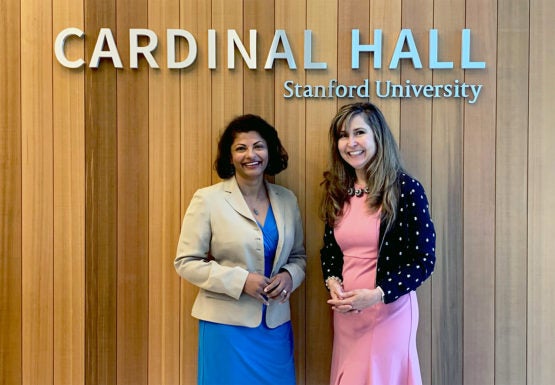Guidelines make resource-conscious purchasing easier at Stanford
Stanford sustainability and procurement experts discuss how recently updated Responsible Purchasing Guidelines can help campus community members make resource-conscious purchases and meet the university’s ambitious sustainability goals.
Under its Long-Range Planning process, Stanford has set an ambitious goal of generating zero waste by 2030, which is defined as at least a 90 percent landfill diversion rate. To help meet that goal, new Responsible Purchasing Guidelines have been established that take a holistic look at purchasing choices, including opportunities for reuse and reduction first, and then the environmental and social impacts of the production, transportation and consumption of necessary products.

From left, Fahmida Bangert, director of sustainability and SEM business services, and Cindy Wilkinson, assistant vice president of procurement services, explain Stanford’s new Responsible Purchasing Guidelines. (Image credit: Ann Rucker)
What this means, for instance, is that campus purchasers will find it easier to seek out reused furniture before purchasing something new, sort out which among many paper options is made from 100 percent recycled content or check Stanford’s Surplus Chemical Inventory before buying new laboratory supplies.
Fahmida Bangert, director of sustainability and SEM business services, and Cindy Wilkinson, assistant vice president of procurement services, explain how Stanford’s new Responsible Purchasing Guidelines work and how new tools being piloted this summer can help the campus community meet the university’s sustainability targets.
What are the Responsible Purchasing Guidelines (RPGs), and why are they important?
Wilkinson: Each year, we spend more than $2.1 billion on goods and services. This collective purchasing power can make a significant impact, both on campus and with industry at large. Sustainability and Procurement Services partnered on these guidelines to ensure that purchasers on campus have the resources to help them exercise their purchasing power and encourage suppliers to act responsibly.
Bangert: The RPGs give an overview of considerations when acquiring goods and services in such high-impact categories as furniture, electronics and lab and office supplies. The guidelines offer purchasing options and a framework for purchasing environmentally friendly, socially responsible and ethically sourced products, while still meeting research and business needs.
What we’re really working toward is a responsible materials management loop, where you are minimizing waste with the purchase decision, and further able to reuse or remake the majority of what you consume, to regenerate resources.
The goods and services we buy that are not a part of this loop will ultimately end up in the landfill. Beyond waste, our practices influence the entire resource consumption life cycle from production to transportation. So, the potential results from an institution that prioritizes responsible purchasing are substantial.
How is Stanford doing so far with sustainable purchasing?
Bangert: In some categories, for example, electronics, more than 90 percent of purchases fall within the RPGs. We hope that responsible purchases will increase with the popularization of the guidelines, especially in some of the larger categories like office supplies or lab consumables. We are piloting tools to aid campus purchasers in spending responsibly and to collect more data about consumer habits.
This will help provide insight as we consider future opportunities. Programs that help coordinate and minimize consumption across departments also support these goals. For example, the Cardinal Print program offers centralized print services to reduce consumption and verifies that printing materials meet the university guidelines.
How can people get involved and participate?
Wilkinson: We hope campus purchasers will review the guidelines and consider the implications of their purchases. Stanford has a number of resources for reuse that could serve as a first option. In addition, this summer we are piloting new tools that can help purchasers find products that fall within the guidelines.
Bangert: We’ve created shopping lists within the Amazon for Business iProcurement system that feature items that meet the RPGs in key categories. These curated lists, while not inclusive of all products, allow consumers to easily purchase responsibly. Also, we are piloting an external product lookup tool that allows purchasers to sort and compare products by spend category, and only includes the products that meet the RPGs. All of the actions that purchasers take in support of responsible purchasing during the pilot period are eligible for points in My Cardinal Green, the online platform that tracks and rewards conservation behavior.
What are the opportunities moving forward?
Wilkinson: In the future, we will work to integrate responsible purchasing up and down the procurement pipeline. We recognize that the campus community is interested in – and supportive of – responsible purchasing, so we remain committed to providing resources that make it simple and straightforward to do so.
Bangert: Because purchasing is so contingent on user norm and cultural behavior, we will use the data captured from this pilot to help inform future programs. We also plan to undertake an internal inventory of Scope 3 emissions – meaning indirect emissions from sources that occur as a result of an institution’s operations, but from sources not owned or controlled by the institution – in the coming year to better understand in which areas purchases can have the most significant impact.
These new guidelines are a starting point. Imagine if we can get to a place where reuse and sharing becomes more prevalent on campus than purchasing new items.
